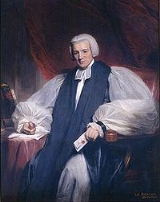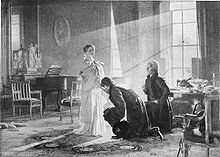
William Howley
Encyclopedia
William Howley was a clergyman in the Church of England
. He served as Archbishop of Canterbury
from 1828 to 1848.
Howley was born in 1766 at Ropley, Hampshire, where his father was vicar. He was educated at Winchester School and in 1783 went to New College, Oxford
. After some time working in Somerset as a private tutor, in 1809 he was appointed regius Professor of Divinity at Oxford University (as well as becoming a Fellow of Winchester and a Canon
of Christ Church, Oxford
.)
He was an active English Freemason, having joined the 'Royal York Lodge
' in Bristol
on 21 December 1791, aged 25, and served the lodge regularly until his elevation to the episcopate took him to London.
In October 1813, at Lambeth Palace
, he was consecrated Bishop of London
, a post he was to occupy until 1828, when he became Archbishop of Canterbury.
(1829) and the passing of the Great Reform Act
(1832.) The bench of bishops was generally opposed to all three measures. As Archbishop, Howley was their spokesman and his heart-felt opposition to the Great Reform Act led to his carriage being attacked in the streets of Canterbury.
Like very many other bishops at that time, Howley was an "old-High Church
man." These inherited a tradition of high views of the sacraments from the Caroline Divines
and their successors. They held Catholic beliefs but were consistently anti-Roman. They were often despised by the more extreme Tractarians and their beliefs were often obscured.
 Archbishop Howley presided over the coronation of William IV
Archbishop Howley presided over the coronation of William IV
and Queen Adelaide
in 1831. At 5 a.m. on 20 June 1837, accompanied by the Lord Chamberlain
, the Marquis Conyngham, the Archbishop went to Kensington Palace
to inform Princess Victoria that she was now Queen of Great Britain and Ireland.
Architecture was of particular interest to him. During his career, he initiated the renovation and/or rebuilding of: his official house at Oxford, his town residence while Bishop of London (32 St. James's Square
), Fulham Palace
(also while he was Bishop of London), and finally, extensive renovations to Lambeth Palace. This last project was a virtual reconstruction of the Palace carried out by Edward Blore
, the work beginning after 1828 and done mainly in the Gothic Revival style. It took several years and cost upwards of £60,000.
William Howley was married on 29 August 1805 to Mary Frances Belli, a daughter of John Belli, EICS, (1740–1805) of Southampton who had been Private Secretary to Warren Hastings
. The Howleys had two sons and three daughters; neither son reached adulthood. One of his daughters married Sir George Howland Willoughby Beaumont, a nephew of Sir George Beaumont, 7th Baronet
. William Howley died in 1848 and was interred at Addington
after an elaborate funeral.
Church of England
The Church of England is the officially established Christian church in England and the Mother Church of the worldwide Anglican Communion. The church considers itself within the tradition of Western Christianity and dates its formal establishment principally to the mission to England by St...
. He served as Archbishop of Canterbury
Archbishop of Canterbury
The Archbishop of Canterbury is the senior bishop and principal leader of the Church of England, the symbolic head of the worldwide Anglican Communion, and the diocesan bishop of the Diocese of Canterbury. In his role as head of the Anglican Communion, the archbishop leads the third largest group...
from 1828 to 1848.
Early Life, education, and interests
Howley's grandfather was, probably, a Lawrence Hooley/Howley of Heaton Mersey: and his uncle, Joseph Hooley [sic] was vicar of Newtown Linford, Leics. Both father and [presumed] uncle went to Brasenose College, Oxford.Howley was born in 1766 at Ropley, Hampshire, where his father was vicar. He was educated at Winchester School and in 1783 went to New College, Oxford
New College, Oxford
New College is one of the constituent colleges of the University of Oxford in the United Kingdom.- Overview :The College's official name, College of St Mary, is the same as that of the older Oriel College; hence, it has been referred to as the "New College of St Mary", and is now almost always...
. After some time working in Somerset as a private tutor, in 1809 he was appointed regius Professor of Divinity at Oxford University (as well as becoming a Fellow of Winchester and a Canon
Canon (priest)
A canon is a priest or minister who is a member of certain bodies of the Christian clergy subject to an ecclesiastical rule ....
of Christ Church, Oxford
Christ Church, Oxford
Christ Church or house of Christ, and thus sometimes known as The House), is one of the largest constituent colleges of the University of Oxford in England...
.)
He was an active English Freemason, having joined the 'Royal York Lodge
Masonic Lodge
This article is about the Masonic term for a membership group. For buildings named Masonic Lodge, see Masonic Lodge A Masonic Lodge, often termed a Private Lodge or Constituent Lodge, is the basic organisation of Freemasonry...
' in Bristol
Bristol
Bristol is a city, unitary authority area and ceremonial county in South West England, with an estimated population of 433,100 for the unitary authority in 2009, and a surrounding Larger Urban Zone with an estimated 1,070,000 residents in 2007...
on 21 December 1791, aged 25, and served the lodge regularly until his elevation to the episcopate took him to London.
In October 1813, at Lambeth Palace
Lambeth Palace
Lambeth Palace is the official London residence of the Archbishop of Canterbury in England. It is located in Lambeth, on the south bank of the River Thames a short distance upstream of the Palace of Westminster on the opposite shore. It was acquired by the archbishopric around 1200...
, he was consecrated Bishop of London
Bishop of London
The Bishop of London is the ordinary of the Church of England Diocese of London in the Province of Canterbury.The diocese covers 458 km² of 17 boroughs of Greater London north of the River Thames and a small part of the County of Surrey...
, a post he was to occupy until 1828, when he became Archbishop of Canterbury.
Life as Archbishop of Canterbury
Howley was Archbishop during the repeal of the Test and Corporation Acts (1828), the Emancipation of the CatholicsCatholic Relief Act 1829
The Roman Catholic Relief Act 1829 was passed by the Parliament of the United Kingdom on 24 March 1829, and received Royal Assent on 13 April. It was the culmination of the process of Catholic Emancipation throughout the nation...
(1829) and the passing of the Great Reform Act
Reform Act 1832
The Representation of the People Act 1832 was an Act of Parliament that introduced wide-ranging changes to the electoral system of England and Wales...
(1832.) The bench of bishops was generally opposed to all three measures. As Archbishop, Howley was their spokesman and his heart-felt opposition to the Great Reform Act led to his carriage being attacked in the streets of Canterbury.
Like very many other bishops at that time, Howley was an "old-High Church
High church
The term "High Church" refers to beliefs and practices of ecclesiology, liturgy and theology, generally with an emphasis on formality, and resistance to "modernization." Although used in connection with various Christian traditions, the term has traditionally been principally associated with the...
man." These inherited a tradition of high views of the sacraments from the Caroline Divines
Caroline Divines
The Caroline Divines were influential theologians and writers in the Anglican Church who lived during the reigns of King Charles I and, after the Restoration, King Charles II . This is commonly considered a golden age of Anglican scholarship...
and their successors. They held Catholic beliefs but were consistently anti-Roman. They were often despised by the more extreme Tractarians and their beliefs were often obscured.

William IV of the United Kingdom
William IV was King of the United Kingdom of Great Britain and Ireland and of Hanover from 26 June 1830 until his death...
and Queen Adelaide
Adelaide of Saxe-Meiningen
Princess Adelaide of Saxe-Meiningen was the queen consort of the United Kingdom and of Hanover as spouse of William IV of the United Kingdom. Adelaide, the capital city of South Australia, is named after her.-Early life:Adelaide was born on 13 August 1792 at Meiningen, Thuringia, Germany...
in 1831. At 5 a.m. on 20 June 1837, accompanied by the Lord Chamberlain
Lord Chamberlain
The Lord Chamberlain or Lord Chamberlain of the Household is one of the chief officers of the Royal Household in the United Kingdom and is to be distinguished from the Lord Great Chamberlain, one of the Great Officers of State....
, the Marquis Conyngham, the Archbishop went to Kensington Palace
Kensington Palace
Kensington Palace is a royal residence set in Kensington Gardens in the Royal Borough of Kensington and Chelsea in London, England. It has been a residence of the British Royal Family since the 17th century and is the official London residence of the Duke and Duchess of Cambridge, the Duke and...
to inform Princess Victoria that she was now Queen of Great Britain and Ireland.
Architecture was of particular interest to him. During his career, he initiated the renovation and/or rebuilding of: his official house at Oxford, his town residence while Bishop of London (32 St. James's Square
St. James's Square
St. James's Square is the only square in the exclusive St James's district of the City of Westminster. It has predominantly Georgian and neo-Georgian architecture and a private garden in the centre...
), Fulham Palace
Fulham Palace
Fulham Palace in Fulham, London , England, at one time the main residence of the Bishop of London, is of medieval origin. It was the country home of the Bishops of London from at least 11th century until 1975, when it was vacated...
(also while he was Bishop of London), and finally, extensive renovations to Lambeth Palace. This last project was a virtual reconstruction of the Palace carried out by Edward Blore
Edward Blore
Edward Blore was a 19th century British landscape and architectural artist, architect and antiquary. He was born in Edinburgh, Scotland ....
, the work beginning after 1828 and done mainly in the Gothic Revival style. It took several years and cost upwards of £60,000.
William Howley was married on 29 August 1805 to Mary Frances Belli, a daughter of John Belli, EICS, (1740–1805) of Southampton who had been Private Secretary to Warren Hastings
Warren Hastings
Warren Hastings PC was the first Governor-General of India, from 1773 to 1785. He was famously accused of corruption in an impeachment in 1787, but was acquitted in 1795. He was made a Privy Councillor in 1814.-Early life:...
. The Howleys had two sons and three daughters; neither son reached adulthood. One of his daughters married Sir George Howland Willoughby Beaumont, a nephew of Sir George Beaumont, 7th Baronet
Sir George Beaumont, 7th Baronet
Sir George Howland Beaumont, 7th Baronet was a British art patron and amateur painter. He played a crucial part in the creation of London's National Gallery by making the first bequest of paintings to that institution....
. William Howley died in 1848 and was interred at Addington
Addington, London
Addington is a district of south London, England, located in the London Borough of Croydon. It is situated south south-east of Charing Cross.-History:...
after an elaborate funeral.

